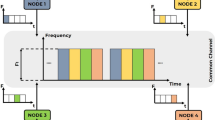Abstract
This article proposes criteria and mechanisms that achieve seamless inter-working between the multi-radio access technologies that will compose the fourth-generation (4G) wireless mobile environment. We address the problem of incorporating system interoperability in order to provide the user with seamless mobility across different radio access technologies; namely we focus on inter-working UMTS-High Speed Downlink Packet Access (HSDPA) and WLAN networks, as these two networks are believed to be major components of the 4G wireless network. Interoperability results in providing the user with a rich range of services across a wide range of propagation environment and mobility conditions, using a single terminal. Specifically, the article aims at defining the criteria and mechanisms for interoperability between the two networks. Our approach considers the use of Cost functions to monitor the essential parameters at the system level in order to trigger an interoperability procedure. Initial user assignment and inter-system handover are considered the incidents that initiate the interoperability algorithm execution. The overall objective of this work is to assess the performance of our developed interoperability platform and to optimize system performance by guarantying a minimum QoS requirement and maximizing network capacity.
Similar content being viewed by others
References
3GPP TR 25.858, High Speed Downlink Packet Access: Physical Layer Aspects.
ETSI/TR 101 683 V1.1.1 (2002–02): BRAN, HiperLAN Type 2, System Overview.
3GPP TR22.934 V6.1.0 (2002–12: Feasibility study on 3GPP system to Wireless ETSI TR101 957, Broadband Radio Access Networks (BRAN); HIPERLAN Type 2; Requirements and Architectures for Interworking between HIPERLAN/2 and 3rd Generation Cellular Systems.
http://www.ist-fitness.org.
R. Pintenet, J. Gosteau, T. Al-Gizawi, F. Lazarakis, K. Peppas, and A. Alexiou, “Evaluation of Interoperability Mechanisms for Co-existing HSDPA and WLAN Enhanced with MTMR Techniques”, VTC fall 2003.
T. Al-Gizawi, K. Peppas, A. Mousa, D. Axiotis, F. Lazarakis, and A. Alexiou, “A Joint HSDPA-HIPERLAN/2 System Level Simulator”, IST-Mobile Summit, Aveiro, June, 2003.
Motorola, “Evaluation Methods for High Speed Downlink Packet Access (HSDPA)”, TSGR1#14(00)0909, 4–7 July, 2000, Oulu, Finland.
Lucent, MIMO System Simulation Methodology, TSGR1(02)0142, 8th–11th January 2002, Espoo, Finland.
Author information
Authors and Affiliations
Rights and permissions
About this article
Cite this article
Al-Gizawi, T., Peppas, K., Lazarakis, F. et al. Evaluation of Interoperability Criteria and Mechanisms for Seamless Inter-Working Between UMTS-HSDPA and WLAN Networks Enhanced with MIMO Techniques. Wireless Personal Communications 30, 119–129 (2004). https://doi.org/10.1023/B:WIRE.0000049394.95228.5b
Issue Date:
DOI: https://doi.org/10.1023/B:WIRE.0000049394.95228.5b




